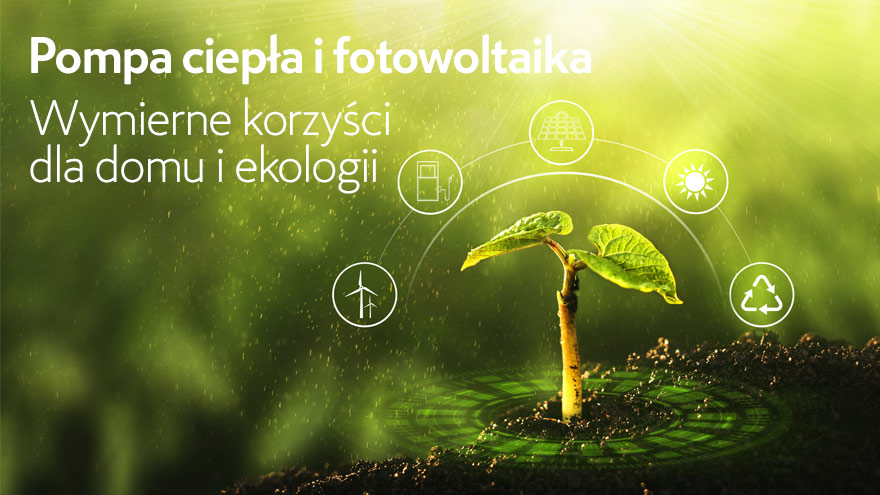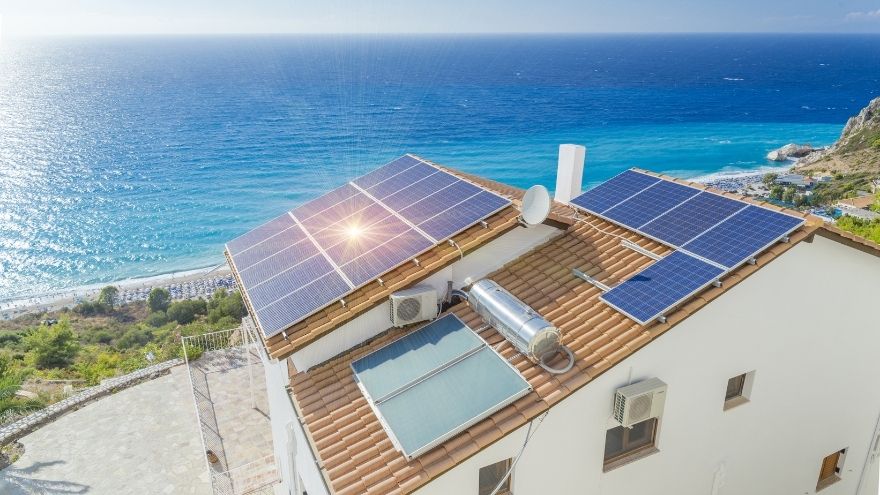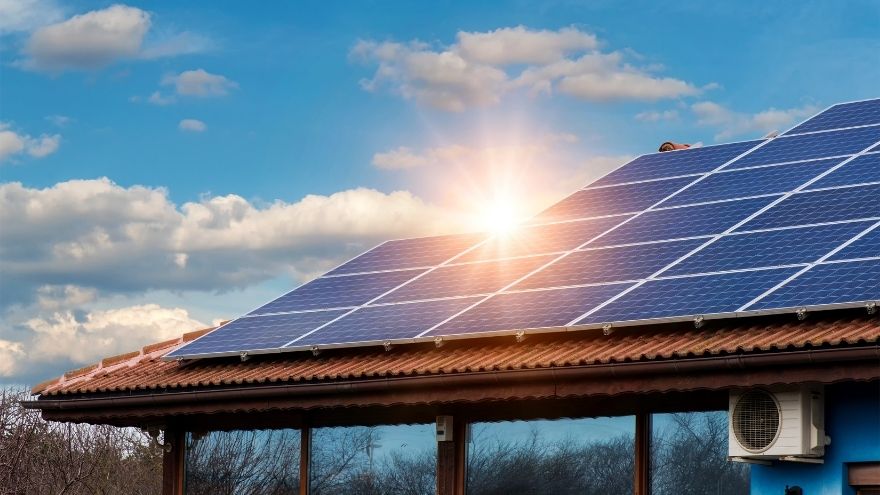Combining a heat pump with a photovoltaic installation is one of the most attractive solutions on the market. In the face of rising fuel prices, such a system can generate huge savings - both in terms of electricity bills and heating bills. Properly selected parameters of both installations will make the operation of the heat pump virtually free. And all this in harmony with the natural environment!

Check out heat pumps at the Onninen wholesaler
What are the advantages of combining a heat pump with a photovoltaic installation?
Using a heat pump and a photovoltaic installation at the same time is the easiest way to drastically reduce the costs of heating a building. Modern heating devices use energy stored in the ground, air or water. They only require relatively small amounts of electricity to operate. To reduce expenses on the latter, the homeowner may decide to install a photovoltaic system.
Photovoltaic panels produce free and ecological electricity. With appropriate power, they can guarantee free operation of the heat pump, as well as other devices in the building.
It is also worth emphasizing the importance of ecological aspects. Heating with a heat pump involves the use of renewable energy sources. The electricity needed for its operation does not have to be produced by burning coal or gas. It can be produced using a photovoltaic installation. Thanks to this solution, the building does not emit harmful substances into the atmosphere and does not contribute to the use of fuels in power plants.
Check out heat pumps at the Onninen wholesaler
What should you consider when choosing a heat pump?
A heat pump is a very attractive solution that can be used to heat rooms or heat domestic water. Its advantages undoubtedly include savings on fuel, maintenance-free operation and no exhaust emissions into the atmosphere. When choosing a heat pump for a building, you should primarily take into account:
- Pump Type – There are two main types of this device on the market. The ground heat pump is characterized by high efficiency and stable operation throughout the year. Due to the large size of the collectors, however, it requires a large plot of land and expensive installation. An air heat pump is a solution whose purchase and installation are much cheaper. However, it must be accepted that its efficiency is greater, the smaller the difference between the external temperature and the target room temperature.
- Pump power - this parameter should be selected in such a way that the device fully covers the building's heat demand. You will learn them, taking into account factors such as the climate zone, the age of the facility and the quality of insulation. This value can range from 10 W/m2 in passive houses to even several hundred W/m2 in old houses without good insulation. Although the heat demand is a key parameter for selecting the pump power, the calculations should also take into account the bivalent temperature, the external daily temperature, the temperature of the upper source along with the parameters of the heating installation, as well as the operation chart of the selected heat pump.
- Alternative heating system - since the operation of air heat pumps may be ineffective during the deepest frosts, they should always be installed in a bivalent system. They are then supported by additional heat sources, such as electric heaters integrated with pumps or even solid fuel boilers.
- Upper heat source - most heat pumps successfully work with a radiator system. However, they are most effective when combined with a low-temperature installation, such as underfloor heating.

Do you have questions about the industry? Join the Świat Instalacji group!
What should you take into account when matching a photovoltaic installation to a heat pump?
To calculate the required power of a photovoltaic installation, you need to know the annual electricity consumption of the heat pump. When specifying this parameter, you may find yourself in one of three situations:
- The heat pump is already used in the building - this is the simplest scenario, in which it is enough to read the amount of electricity consumed from the heat pump controller's meter . In a modern device, you will easily find the value for a whole year of operation in space heating and domestic hot water preparation mode.
- The heat pump is to be located in a newly constructed building - in this case , not only the power of the photovoltaic installation must be estimated, but also the power of the heat pump . We have already written about how to calculate this second value. On this basis, you can easily determine the projected electricity consumption of the device.
- The heat pump is to be installed in a building that is being modernized - in such a situation, the heat demand is usually determined through an energy audit. As a result, you will find out how many kilowatts the heat pump must produce per year. Thanks to this, you can easily calculate its electricity demand and, therefore, the necessary power of photovoltaic panels. You can also refer to the building energy standard , according to which:
- a house built before 1967 requires 240 - 350 kWh of heat/m2 per year,
- a house from 1967 - 1985 requires 240 - 290 kWh/m2 per year,
- a house from 1986 - 1992 requires 160 - 200 kWh/m2 per year,
- a house from 1993 - 1997 requires 120 - 160 kWh/m2 per year,
- a house built after 1998 requires 90 - 120 kWh/m2 per year.
 If the specificity of the building and the investor's budget allow it, the size of the photovoltaic installation may exceed the energy demand of the pump. In such a situation, the panels will also power other household appliances. When prosumers stopped being settled under the discount system, it became profitable to install the largest possible installations. Assuming that the energy produced is used on an ongoing basis and stored on its own, the homeowner can not only become independent from the power grid, but even make money on resold surpluses.
If the specificity of the building and the investor's budget allow it, the size of the photovoltaic installation may exceed the energy demand of the pump. In such a situation, the panels will also power other household appliances. When prosumers stopped being settled under the discount system, it became profitable to install the largest possible installations. Assuming that the energy produced is used on an ongoing basis and stored on its own, the homeowner can not only become independent from the power grid, but even make money on resold surpluses.
Heat pumps and photovoltaic panels in the Onninen offer
When planning to install a photovoltaic installation with a heat pump, buy efficient devices that you can find in our online wholesaler. Onninen's offer includes, among others:
- Atlantic EXTENSA AI DUO R32 air heat pump — a device with a heating power of 10 kW, equipped with a domestic hot water heater with a capacity of 190 l. It is characterized by a coaxial heat exchanger, intuitive interface and the possibility of remote operation using the Cozytouch application.
- Galmet MAXIMA 7 GT ground heat pump — a model with a heating power of 7 kW, used both for heating rooms and preparing domestic hot water. It guarantees stable operating parameters regardless of the external temperature. The device is equipped with a system managed via a touch panel, room controller or dedicated online application.
- Ja Solar JAM54S30 photovoltaic panels — high-efficiency monocrystalline modules, made using half-cell technology. Compared to standard panels, they have lower internal resistance and lower power losses. Their efficiency is also due to the favorable power temperature coefficient and the reduced impact of shading on energy generation.
In the Onninen assortment, you will easily find high-quality products that will perfectly meet the needs of your customers!